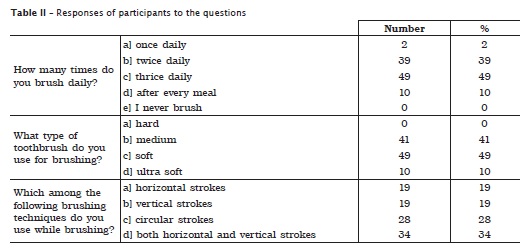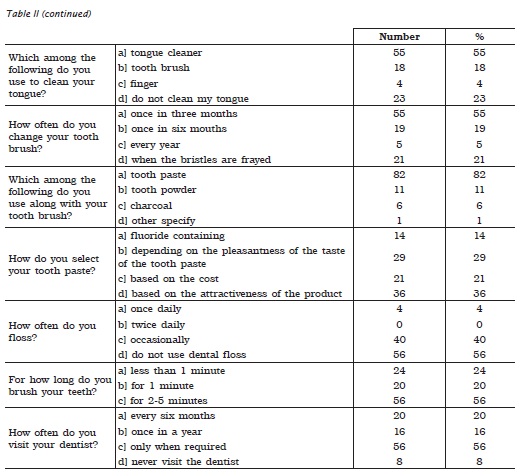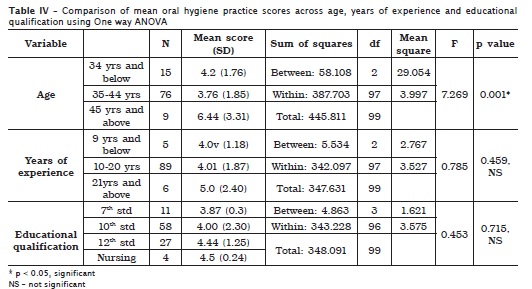Services on Demand
Article
Related links
Share
RSBO (Online)
On-line version ISSN 1984-5685
RSBO (Online) vol.10 n.3 Joinville Jul./Sep. 2013
ORIGINAL RESEARCH ARTICLE
Oral hygiene practices among paramedical staff of a private dental institution in India
Amith Holenarasipur VasanthakumarI; Audrey Madonna D'CruzII; Shahima SamadIII; ShanimaIII; Shazmi Hasan DhindaIII; Sheikh Mohammad MansibIII; Shreya NayakIII
IDepartment of Public Health Dentistry, People's College of Dental Sciences and Research Centre, People's University – Bhopal – Madhya Pradesh – India.
IIDepartment of Public Health Dentistry, A. B. Shetty Memorial Institute of Dental Sciences, Nitte University – Mangalore – Karnataka – India.
IIIUndergraduate students, A. B. Shetty Memorial Institute of Dental Sciences. Nitte University - Mangalore - Karnataka - India.
ABSTRACT
Introduction: Health promotion in dentistry is targeted at the two most common oral diseases – dental caries and periodontal disease. The maintenance of good oral hygiene is considered to be a central issue in oral health promotion.
Objective: To assess the oral hygiene practices among paramedical staff of a private dental institution in India.
Material and methods: A cross sectional questionnaire survey was undertaken among 100 paramedical staff of a private dental institution in Mangalore, India. Data was collected by using self designed questionnaire.
Results: About 49% of the subjects brushed thrice with soft toothbrush and 55% changed their tooth brush once in 3 months. About 77% of them cleaned their tongue either by tongue cleaner, toothbrush or finger and 82% of the subjects used tooth paste. About 56% of the subjects had never used dental floss. Majority of the subjects (56%) visited the dentist only when required.
Conclusion: Oral hygiene practices among the paramedical staff were poor.
Keywords: dental plaque; oral health; tooth brushing.
Introduction
Health behavior is defined as "the activities undertaken by people in order to protect, promote or maintain health and to prevent disease" 10. The broad categories of factors that may influence individual and community health behavior include: knowledge, beliefs, values, attitudes, skills, finance, materials, time and the influence of family members, friends, co-workers, opinion leaders and even health workers themselves 8. Health promotion in dentistry is targeted at the two most common oral diseases – dental caries and periodontal disease 1. The maintenance of good oral hygiene is considered to be a central issue in oral health promotion. The cornerstone of prevention of the two major oral diseases, dental caries and periodontal disease, is the maintenance of a clean mouth or a clean tooth surface 3. A clean tooth surface is one which is free from dental plaque. The people who have assimilated the knowledge and feel a sense of personal control over their oral health are more likely to adopt self-care behaviour 1. Good oral hygiene and a positive attitude towards maintaining it, reflects individual's health, confidence, life style and personality also 11. Habits like cleaning of teeth, use of mouth rinse, use of tobacco and smoking affect the oral hygiene and oral health 11.
Paramedical staff such as receptionists, nurses, technicians, attenders forms an important group in a dental institution. They play a role of linking between patients and doctors in the hospital. It is therefore important that auxiliary staff caring for people in hospitals themselves have a core of knowledge of their oral care needs. They are also expected to maintain their oral hygiene. There is scarce published literature on assessment of oral hygiene practices of paramedical staff in India. Hence, this study aimed to assess the oral hygiene practices among paramedical staff of a private dental institution in India. The null hypothesis for the present study was that the oral hygiene practices among the paramedical staff were poor.
Material and methods
A cross sectional questionnaire survey was undertaken among the paramedical staff of A. B. Shetty Memorial Institute of Dental Sciences, Nitte University, Mangalore, India during the period August-September 2011. The study protocol was reviewed and ethical approval was obtained by the Institutional ethical committee (ABSM/EC/25/2011).
Survey instrument
A self designed, close ended questionnaire was developed in English language. Each questionnaire contained two parts: the first part dealt with basic demographic details of the participants, the second part dealt with the questions regarding practice of oral hygiene.
Questionnaire reliability
A pilot study was conducted on 10% of the total sample size i.e. 10 paramedical staff in order to check the feasibility of the study and to check the adequacy of the questions 12. Based on the results of the pilot study, the questionnaire was revised and modified. Questionnaire showed high degree (0.91) of agreement during test-retest of questionnaire. Those individuals who participated in the pilot study were not considered for the main study to prevent possible bias.
Study sample
There are 125 paramedical staff (receptionists, nurses, technicians, attenders) working in A. B. Shetty Memorial Institute of Dental Sciences, Mangalore, India. Subjects who were not present during three consecutive visits were excluded from the study. The purpose of the study was explained to each participant and informed consent was obtained from each participant who was willing to participate in the study. Participation was voluntary, and all the participants were queried anonymously. The questionnaires were collected in person immediately after completion.
Statistical analysis
A score of '1' for each correct answer and '0' for every wrong answer was given. The scores for all the 10 questions were added together to obtain an "oral hygiene practice score" for each individual. Overall mean oral hygiene practice score was calculated by dividing the total oral hygiene practice scores of all individuals by the number of individuals.
Comparison of mean scores between the genders was done using Unpaired t test. The participants were categorized into three categories based on their age as 34 years and below, 35 – 44 years and 45 years and above. Comparison of mean oral hygiene practice scores of the three age groups was executed using One-way ANOVA. The years of experience was categorized into 9 years and below, 10-20 years and 21 years and above. Comparison of mean oral hygiene practice scores across the years of experience was done using One-way ANOVA. Comparison of mean scores across four qualification groups (7th standard, 10th standard, 12th standard and nursing) was performed using One-way ANOVA. The level of significance was set at 5% and probability value of <0.05 was considered as statistically significant. The data were tabulated and analyzed using SPSS 16.0 version (SPSS Inc., Chicago, IL, USA).
Results
The present study was carried out to assess the oral hygiene practices of paramedical staff of a private dental institution in Mangalore, India. Of the 125 paramedical staff, 100 participated in the survey. The response rate was 80%. Table I shows the sociodemographic characteristics of the study participants'. The study group consisted of 70 females and 30 males with a mean age of 39.25 years and having a mean experience of 14.25 years.

Table II shows the responses of the study participants to the questions asked regarding their oral hygiene practices. It was noted that about 49% of the subjects brushed thrice with soft toothbrush. Around 34% of them brushed their teeth using both horizontal and vertical strokes. About 55% of them cleaned their tongue by tongue cleaner and 18% used a toothbrush for tongue cleaning. However, 23% never cleaned their tongue. About 55% changed their tooth brush once in 3 months. Majority of the participants' (82%) used tooth paste along with the toothbrush for brushing their teeth. However, only 14% selected the toothpaste because of its fluoride content. Most of them selected the toothpaste based on the attractiveness of the product. About 56% of the participants' brushed their teeth for about 2-5 minutes. When enquired about flossing, 40% of the subjects' flossed occasionally and 56% of them had never used dental floss. Only 20% of the subjects visited a dentist every 6 months. Majority of the subjects (56%) visited the dentist only when required and 8% had never visited a dentist.


Table III shows the mean practice score across genders. The overall mean of oral hygiene practice score was 4.07±1.48. The mean score for males was 1.3±2.58 and that for females was 3.96±2.03. Unpaired t test shows that the difference in mean scores across genders was statistically significant (p < 0.05).

Table IV shows the mean oral hygiene practice score across age, educational qualification and years of experience. The mean scores of participants 34yrs and below, 35-44yrs and 45yrs and above of age were 4.2±1.76, 3.76±1.85 and 6.44±3.31 respectively. The difference in mean scores across various age groups was statistically significant using One-way ANOVA test (p < 0.05, significant). The study participants having an experience of 9yrs and below had a mean score of 4.0±1.18, those of 10-20 yrs experience had a mean score of 4.01±1.87 and those 21 years and above had a mean score of 5.0±2.40; the difference of which was not statistically significant (p > 0.05).
Based on their educational qualification, those who had studied up to 7th standard, 10th standard, 12th standard and nursing education had a mean score of 3.87±0.3, 4.0±2.30, 4.44±1.25 and 4.5±0.24 respectively. Although there was a marginal increase in the mean practice scores with an increase in the educational qualification, the difference was not statistically significant (p < 0.05) (table IV).

The results of the present study reveal that oral hygiene practices among the paramedical staff were poor and hence the null hypothesis was accepted.
Discussion
Oral health care is considered as of primary importance in general health care 11. The effective tooth cleaning practices are indicative of positive oral health behavior whereas frequent consumption of sugary foods represents negative health behavior (risk behavior) 9. Regular removal of dento-gingival plaque is crucial for the maintenance of oral health, free from dental caries and periodontal disease 4. Although the mechanical cleaning is useful in controlling supragingival plaque, it depends on person's capabilities to maintain a good standard 2,5. For a motivated, well-instructed person with time and skill, mechanical plaque-control measures are sufficient to attain complete dental health 2. A number of factors have been suggested as playing a role in motivation of people in performing oral hygiene procedures 5. Most important amongst these factors are self recognition of the disease and the knowledge of various preventive measures 5.
Paramedical staff in a dental college forms an important part of the dental team. Their role is essential in maintaining asepsis, maintaining records, fixing appointments, delivering oral hygiene instructions etc. Hence, assessment of their oral hygiene practices too becomes important.
The results of the present study revealed that all of them were performing tooth brushing on a daily basis. This was similar to the findings of Kaira et al. 7 where all the nursing students performed tooth brushing. About 82% of the participants in the present study were using toothpaste. This was higher to that reported byKaira et al. 7 where 70% of nursing students used toothpaste. In the present study, although 82% of them were using toothpaste, only 14% of them were aware that they need to select toothpaste based on whether it contains fluoride or not. Most of them selected and purchased the toothpaste based on the attractiveness of the product. It is quite surprising that in spite of working in a dental college and with the availability of free dental services, 8% of the paramedical staff had never consulted a dentist. These results show the gap in oral health knowledge among this particular population. The findings of this study were similar to study conducted in Mississippi in which knowledge of dental health was lacking among the nursing staff of nursing homes 6.
When compared gender wise, females had a better oral hygiene practice score (3.96±2.03) than males (1.3±2.58). This may be due to the fact that females are generally more hygiene conscious than males 10.
The results of this study must be interpreted in the context of potential methodological limitations. Since this survey was self-reported data, there exists a tendency of respondents to provide socially acceptable answers. However, such surveys maybe helpful in planning oral health education programs for the paramedical staff. It is recommended that oral health education programs be conducted regularly in the dental colleges to improve the oral hygiene knowledge and practices among this particular group.
Conclusion
The oral hygiene practices among the paramedical staff of A. B. Shetty Memorial Institute of Dental Sciences were poor.
References
1. Brukiene V, Aleksejuniene J. An overview of oral health promotion in adolescents. Int J Paed Dent. 2009;19:163-71. [ Links ]
2. Claydon CN. Current concepts in toothbrushing and interdental cleaning. Periodontol 2000. 2008;48:10-22. [ Links ]
3. D'Cruz AM, Shankar Aradhya MR. Impact of oral health education on oral hygiene knowledge, practices, plaque control and gingival health of 13- to 15-year-old school children in Bangalore city. Int J Dent Hygiene. 2012. [ Links ]
4. Haas AN, Reis A, Lemos Jr. CA, Pannuti CM, Escobar E, Almeida ER et al. Daily biofilm control and oral health: an epidemiological challenge consensus – Brazilian advisory panel in oral health. Braz J Periodontol. 2012;22(3):40-6.
5. Hebbal M, Ankola AV, Vadavi D, Patel K. Evaluation of knowledge and plaque scores in school children before and after health education. Dent Res J. 2011;8:189-96. [ Links ]
6. Howard RM. Survey of oral hygiene knowledge and practice among Mississippi nursing home staff [cited 2013 Mar 16]. Available from: URL:http://udini.proquest.com/view/survey-of-oral-hygiene-knowledge-goid:868355421/. [ Links ]
7. Kaira LS, Srivastava V, Giri P, Chopra D. Oral health related knowledge, attitude and practice among nursing students of Rohilkhand Medical college and hospital: a questionnaire study. J Orofac Res. 2012;2(1):20-3. [ Links ]
8. Park K. Park's textbook of preventive and social medicine. 18th ed. Banarsidas Bhanot Publishers; 2005. [ Links ]
9. Pine CM, Harris R. Community oral health. 2nd ed. Quintessence Book Publishing Co.; 2007. [ Links ]
10. Sharda AJ, Shetty S. A comparative study of oral health knowledge, attitude and behaviour of non-medical, para-medical and medical students in Udaipur city, Rajasthan, India. Int J Dent Hygiene. 2010;8:101-9. [ Links ]
11. US Department of Health and Human Services. Oral health in America: a report of the surgeon general – executive summary. Rockville, MD: US Department of Health and Human Services, National Institute of Dental and Craniofacial Research, National Institutes of Health; 2000.
12. WHO. Health research methodology. A guide for training in research methods. 2nd ed. World Health Organization; 2001. [ Links ]
 Corresponding author:
Corresponding author:
Amith H. V.
Department of Public Health Dentistry
People's College of Dental Sciences and Research Centre, People's University
Bhanpur – Bhopal – Madhya Pradesh – India
E-mail: amith_hv@yahoo.co.in
Received for publication: December 17, 2012
Accepted for publication: April 8, 2013













